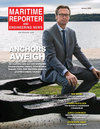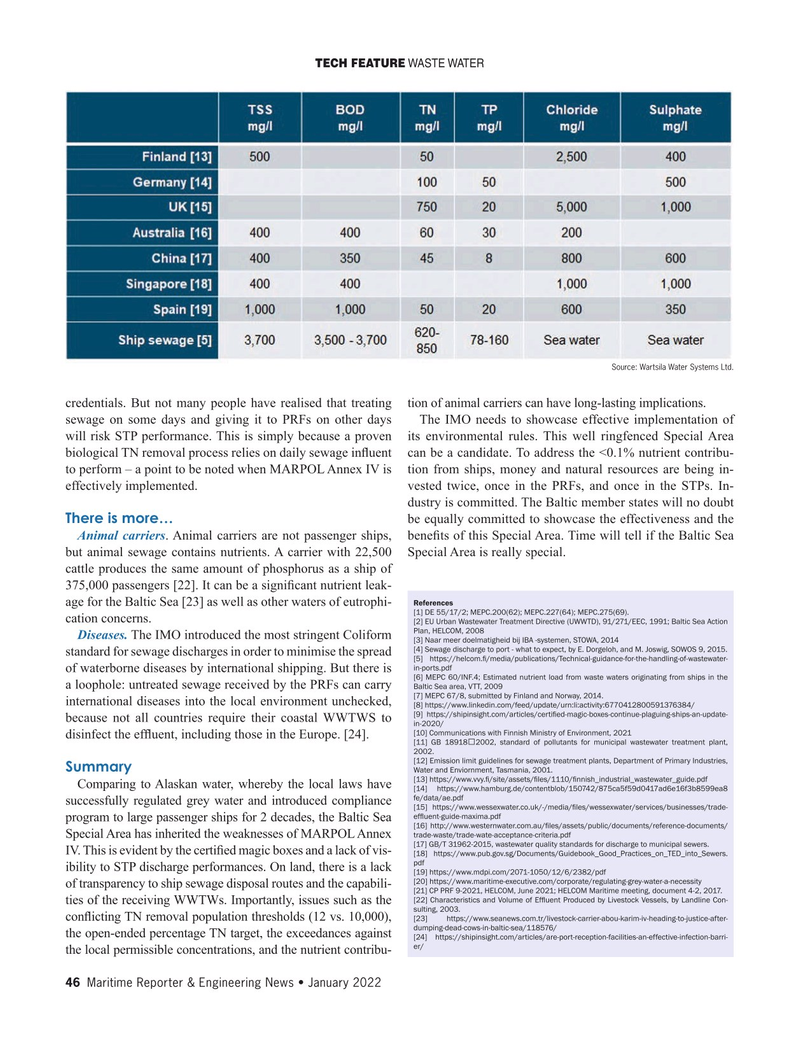
Page 46: of Maritime Reporter Magazine (January 2022)
The Ship Repair & Conversion Edition
Read this page in Pdf, Flash or Html5 edition of January 2022 Maritime Reporter Magazine
TECH FEATURE WASTE WATER
Source: Wartsila Water Systems Ltd.
credentials. But not many people have realised that treating tion of animal carriers can have long-lasting implications. sewage on some days and giving it to PRFs on other days The IMO needs to showcase effective implementation of will risk STP performance. This is simply because a proven its environmental rules. This well ringfenced Special Area biological TN removal process relies on daily sewage in? uent can be a candidate. To address the <0.1% nutrient contribu- to perform – a point to be noted when MARPOL Annex IV is tion from ships, money and natural resources are being in- effectively implemented. vested twice, once in the PRFs, and once in the STPs. In- dustry is committed. The Baltic member states will no doubt
There is more… be equally committed to showcase the effectiveness and the
Animal carriers. Animal carriers are not passenger ships, bene? ts of this Special Area. Time will tell if the Baltic Sea but animal sewage contains nutrients. A carrier with 22,500 Special Area is really special. cattle produces the same amount of phosphorus as a ship of 375,000 passengers [22]. It can be a signi? cant nutrient leak-
References age for the Baltic Sea [23] as well as other waters of eutrophi- [1] DE 55/17/2; MEPC.200(62); MEPC.227(64); MEPC.275(69).
cation concerns.
[2] EU Urban Wastewater Treatment Directive (UWWTD), 91/271/EEC, 1991; Baltic Sea Action
Plan, HELCOM, 2008
Diseases. The IMO introduced the most stringent Coliform [3] Naar meer doelmatigheid bij IBA -systemen, STOWA, 2014 [4] Sewage discharge to port - what to expect, by E. Dorgeloh, and M. Joswig, SOWOS 9, 2015. standard for sewage discharges in order to minimise the spread [5] https://helcom.? /media/publications/Technical-guidance-for-the-handling-of-wastewater- in-ports.pdf of waterborne diseases by international shipping. But there is [6] MEPC 60/INF.4; Estimated nutrient load from waste waters originating from ships in the a loophole: untreated sewage received by the PRFs can carry
Baltic Sea area, VTT, 2009 [7] MEPC 67/8, submitted by Finland and Norway, 2014.
international diseases into the local environment unchecked, [8] https://www.linkedin.com/feed/update/urn:li:activity:6770412800591376384/ [9] https://shipinsight.com/articles/certi? ed-magic-boxes-continue-plaguing-ships-an-update- because not all countries require their coastal WWTWS to in-2020/ [10] Communications with Finnish Ministry of Environment, 2021 disinfect the ef? uent, including those in the Europe. [24].
[11] GB 18918?2002, standard of pollutants for municipal wastewater treatment plant, 2002. [12] Emission limit guidelines for sewage treatment plants, Department of Primary Industries,
Summary
Water and Enviornment, Tasmania, 2001.
[13] https://www.vvy.? /site/assets/? les/1110/? nnish_industrial_wastewater_guide.pdf
Comparing to Alaskan water, whereby the local laws have [14] https://www.hamburg.de/contentblob/150742/875ca5f59d0417ad6e16f3b8599ea8 fe/data/ae.pdf successfully regulated grey water and introduced compliance [15] https://www.wessexwater.co.uk/-/media/? les/wessexwater/services/businesses/trade- ef? uent-guide-maxima.pdf program to large passenger ships for 2 decades, the Baltic Sea [16] http://www.westernwater.com.au/? les/assets/public/documents/reference-documents/ trade-waste/trade-wate-acceptance-criteria.pdf
Special Area has inherited the weaknesses of MARPOL Annex [17] GB/T 31962-2015, wastewater quality standards for discharge to municipal sewers.
IV. This is evident by the certi? ed magic boxes and a lack of vis- [18] https://www.pub.gov.sg/Documents/Guidebook_Good_Practices_on_TED_into_Sewers.
pdf ibility to STP discharge performances. On land, there is a lack [19] https://www.mdpi.com/2071-1050/12/6/2382/pdf [20] https://www.maritime-executive.com/corporate/regulating-grey-water-a-necessity of transparency to ship sewage disposal routes and the capabili- [21] CP PRF 9-2021, HELCOM, June 2021; HELCOM Maritime meeting, document 4-2, 2017.
[22] Characteristics and Volume of Ef? uent Produced by Livestock Vessels, by Landline Con- ties of the receiving WWTWs. Importantly, issues such as the sulting, 2003.
con? icting TN removal population thresholds (12 vs. 10,000), [23] https://www.seanews.com.tr/livestock-carrier-abou-karim-iv-heading-to-justice-after- dumping-dead-cows-in-baltic-sea/118576/ the open-ended percentage TN target, the exceedances against [24] https://shipinsight.com/articles/are-port-reception-facilities-an-effective-infection-barri- er/ the local permissible concentrations, and the nutrient contribu- 46 Maritime Reporter & Engineering News • January 2022
MR #1 (34-49).indd 46 1/6/2022 10:08:51 AM

 45
45

 47
47
